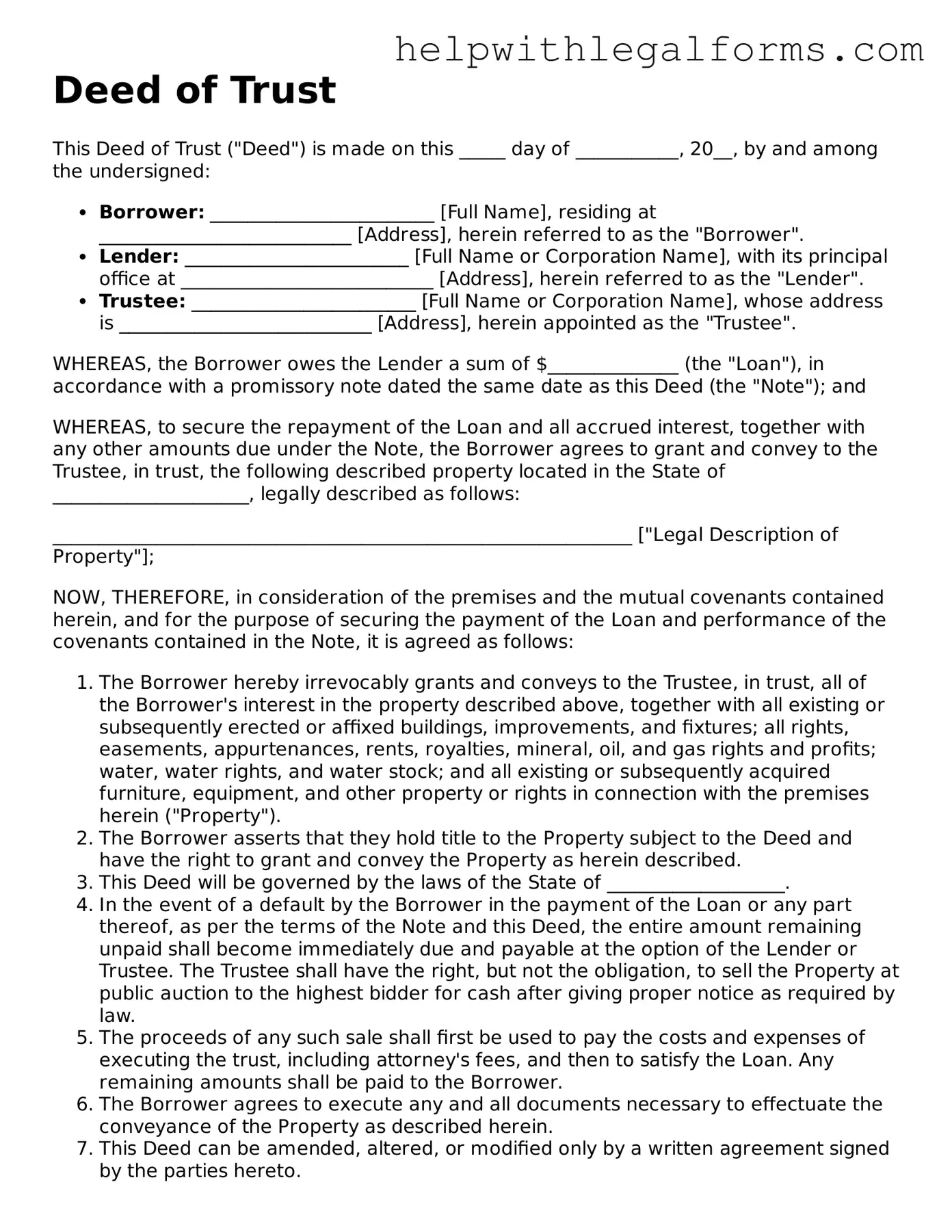Deed of Trust
This Deed of Trust ("Deed") is made on this _____ day of ___________, 20__, by and among the undersigned:
- Borrower: ________________________ [Full Name], residing at ___________________________ [Address], herein referred to as the "Borrower".
- Lender: ________________________ [Full Name or Corporation Name], with its principal office at ___________________________ [Address], herein referred to as the "Lender".
- Trustee: ________________________ [Full Name or Corporation Name], whose address is ___________________________ [Address], herein appointed as the "Trustee".
WHEREAS, the Borrower owes the Lender a sum of $______________ (the "Loan"), in accordance with a promissory note dated the same date as this Deed (the "Note"); and
WHEREAS, to secure the repayment of the Loan and all accrued interest, together with any other amounts due under the Note, the Borrower agrees to grant and convey to the Trustee, in trust, the following described property located in the State of _____________________, legally described as follows:
______________________________________________________________ ["Legal Description of Property"];
NOW, THEREFORE, in consideration of the premises and the mutual covenants contained herein, and for the purpose of securing the payment of the Loan and performance of the covenants contained in the Note, it is agreed as follows:
- The Borrower hereby irrevocably grants and conveys to the Trustee, in trust, all of the Borrower's interest in the property described above, together with all existing or subsequently erected or affixed buildings, improvements, and fixtures; all rights, easements, appurtenances, rents, royalties, mineral, oil, and gas rights and profits; water, water rights, and water stock; and all existing or subsequently acquired furniture, equipment, and other property or rights in connection with the premises herein ("Property").
- The Borrower asserts that they hold title to the Property subject to the Deed and have the right to grant and convey the Property as herein described.
- This Deed will be governed by the laws of the State of ___________________.
- In the event of a default by the Borrower in the payment of the Loan or any part thereof, as per the terms of the Note and this Deed, the entire amount remaining unpaid shall become immediately due and payable at the option of the Lender or Trustee. The Trustee shall have the right, but not the obligation, to sell the Property at public auction to the highest bidder for cash after giving proper notice as required by law.
- The proceeds of any such sale shall first be used to pay the costs and expenses of executing the trust, including attorney's fees, and then to satisfy the Loan. Any remaining amounts shall be paid to the Borrower.
- The Borrower agrees to execute any and all documents necessary to effectuate the conveyance of the Property as described herein.
- This Deed can be amended, altered, or modified only by a written agreement signed by the parties hereto.
- This Deed constitutes the entire agreement between the parties concerning the subject matter hereof and supersedes all prior agreements and understandings, whether written or oral.
IN WITNESS WHEREOF, the parties have executed this Deed as of the date first above written.
_________________________
Borrower's Signature
_________________________
Lender's Signature
_________________________
Trustee's Signature
